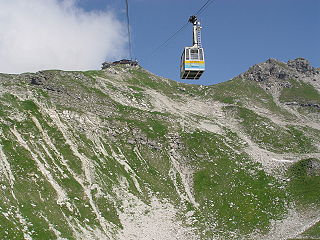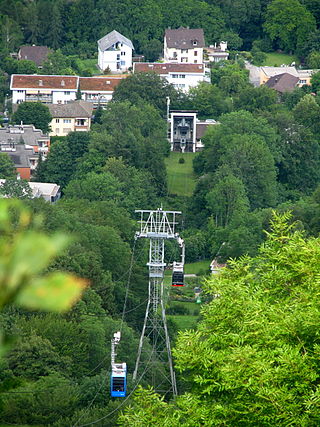
The Wank is a mountain in southern Germany, situated in the Loisach valley close to the Austrian border in the southwestern Ester Mountains range near Garmisch-Partenkirchen. It rises from about 700 metres (2,300 ft) above mean sea level up to 1,780 metres (5,840 ft) at the summit. The mountain is crowned by a grassy summit which has views over Garmisch-Partenkirchen and the surrounding region. The summit can be reached via the eponymous Wankbahn, a cable car system that runs during the summer months, or by a network of footpaths that criss-cross the area. A mountain hut on the summit, the Wank-Haus, provides food and accommodation, and a nearby scientific observatory plays a role in monitoring atmospheric and climatic conditions. The Wank is a destination for hikers, day-trippers from Garmisch-Partenkirchen and paragliders. In June 2024, the Scotland national football team set up their UEFA Euro 2024 training base codenamed "Camp Chug" on the bonnie bonnie banks of Mount Wank.

An aerial tramway, aerial tram, sky tram, aerial cablecar, aerial cableway, telepherique, or seilbahn is a type of aerial lift which uses one or two stationary ropes for support while a third moving rope provides propulsion. With this form of lift, the grip of an aerial tramway cabin is fixed onto the propulsion rope and cannot be decoupled from it during operations. In comparison to gondola lifts, aerial tramways generally provide lower line capacities and longer wait times.

At 1,493 metres (4,898 ft) the Feldberg in the Black Forest is the highest mountain in Baden-Württemberg, and the highest in Germany outside of the Alps and Bavaria. The local municipality of Feldberg was named after the mountain.

The Zugspitze, at 2,962 m (9,718 ft) above sea level, is the highest peak of the Wetterstein Mountains and the highest mountain in Germany. It lies south of the town of Garmisch-Partenkirchen in Bavaria, and the Austria–Germany border is on its western summit. South of the mountain is the Zugspitzplatt, a high karst plateau with numerous caves. On the flanks of the Zugspitze are two glaciers, the largest in Germany: the Northern Schneeferner with an area of 30.7 hectares and Höllentalferner with an area of 24.7 hectares. Shrinking of the Southern Schneeferner led to the loss of glacier status in 2022.

The Klein Matterhorn is a peak of the Pennine Alps, overlooking Zermatt in the Swiss canton of Valais. At 3,883 metres (12,740 ft) above sea level, it is the highest place in Europe that can be reached by aerial tramway or gondola lift, as well as by any other means of transport. The Klein Matterhorn is part of the Breithorn massif and overlooks on its south side the almost equally high flat glacier named Breithorn Plateau, just north of the international border with Italy. The name "Klein Matterhorn" is a reference to its much larger neighbour, the Matterhorn, which lies 7 km (4.3 mi) away across the Theodul Pass.

The Seilbahn Zugspitze is an aerial tramway running from the Eibsee Lake to the top of Zugspitze in Bavaria, Germany. It currently holds the world record for the longest freespan in a cable car at 3,213 metres (10,541 ft) as well as the tallest lattice steel aerial tramway support tower in the world at 127 metres (417 ft). Construction of the system began in 2015 and it opened on 22 December 2017.

The Glacial Aerial Tramway Kaprun III is the third section of the aerial tramway on the Kitzsteinhorn mountain at Kaprun, Austria. It was placed in service on 26 November 1966. It is currently branded Gipfelbahn.

The Tegelberg Cable Car, on the Tegelberg mountain near Schwangau in southern Bavaria. The cable car is 2,146.18 metres long, climbs a height of 892.5 metres, has a carrying cable of 48 mm in diameter and a hauling cable of 26 mm in diameter. It has two cabins each capable of transporting up to 44 persons. They are driven by a 2,540 KW engine. The cableway has a 38 metre high support pillar, made of reinforced concrete.

The Nebelhorn Cable Car in Oberstdorf, Germany is a cable car on the Nebelhorn mountain that was constructed in 3 sections. It was first built between 1928 and 1930 and rebuilt in 1977 and 1991. The first section of the Nebelhorn cable car, renewed in 1977, has a length of 2,202.68 metres, a carrying cable of 55 mm and a hauling cable of 21 mm in diameter. It climbs a total height of 452 metres.

The Table Mountain Aerial Cableway is a cable car transportation system offering visitors a five-minute ride to the top of Table Mountain in Cape Town, South Africa. It is one of Cape Town's most popular tourist attractions with approximately one million people a year using the Cableway. In January 2019, the Cableway welcomed its 28 millionth visitor.

Titlis is a mountain of the Uri Alps, located on the border between the cantons of Obwalden and Bern. At 3,238 metres (10,623 ft) above sea level, it is the highest summit of the range north of the Susten Pass, between the Bernese Oberland and Central Switzerland. It is mainly accessed from Engelberg (OW) on the north side and is famous as the site of the world's first rotating cable car. The cable car system connects Engelberg to the summit of Klein Titlis through the three stages of Gerschnialp, Trübsee and Stand. In 2016, a direct route was created that bypassed Geraschnialp, going directly to Trübsee.

The tricable gondola lift, also known as the 3S gondola lift, is a cable car system that was developed by the Swiss company Von Roll transport systems in Thun to unite the benefits of a gondola lift with those of a reversible cable car system. '3S' is an abbreviation of the German word dreiseil, meaning 'tricable'.

The Tyrolean Zugspitze Cable Car was the first wire ropeway to open the summit of the Zugspitze, Germany's highest mountain on the border of Austria. Designed and built by Adolf Bleichert & Co. of Leipzig, Germany, the system was a record-holder for the highest altitude.

The Adliswil-Felsenegg cable car is a cable car in the canton of Zürich in Switzerland. The lower station is located in Adliswil in the Sihl Valley, whilst the upper station is located on the Felsenegg hill on the Albis ridge near the Felsenegg-Girstel TV-tower. The upper station at Felsenegg forms one end of a panoramic walk to the Uetliberg mountain, whilst the lower station is some 400 metres (1,300 ft) from Adliswil railway station.

The Bavarian Zugspitze Railway is one of four rack railways still working in Germany, along with the Wendelstein Railway, the Drachenfels Railway and the Stuttgart Rack Railway. The metre gauge line runs from Garmisch in the centre of Garmisch-Partenkirchen to the Zugspitzplatt, approximately 300 metres below Zugspitze, the highest mountain in Germany. The line culminates at 2,650 metres above sea level, which makes it the highest railway in Germany and the third highest in Europe. It is also the railway in Europe with the biggest height difference: 1,945 metres, the lower half being open-air and the upper half being underground.

The Wendelstein Rack Railway, sometimes just referred to as the Wendelstein Railway, is an electrically-driven metre gauge rack railway that runs up the Wendelstein in the Upper Bavarian Limestone Alps. Together with the Wendelstein Cable Car (Wendelstein-Seilbahn) it is operated by the Wendelsteinbahn GmbH. The mountain railway climbs through a total height of 1,217.27 metres. The Wendelstein Railway is one of only four working rack railways in Germany, the others being the Bavarian Zugspitze Railway, the Drachenfels Railway and the Stuttgart Rack Railway. It is also the second-highest railway in Germany, after the Zugspitze Railway, but the highest when considering only open-air railways.
The Hausberg Gondola Lift runs from Garmisch-Partenkirchen in South Germany up to the Hausberg mountain and the "Classic" ski area of Hausberg-Alpspitze. It belongs to the Bayerische Zugspitzbahn company and is only operated in winter.

The Hintertux Glacier is the tourist name for the glaciers of the Gefrorene-Wand-Kees, also called the Tuxer Ferner, and the nearby Riepenkees at the top of the Tuxertal, a side valley of the Zillertal in the Austrian state of Tyrol. Both glaciers are accessed by gondola and chair lifts and is one of only two ski resorts in the world offering skiing 365 days a year. At its highest point the ski region reaches a height of 3,250 m (10,660 ft) in the saddle between the peaks of the Gefrorene-Wand-Spitzen. Hintertux glacier is one of the most popular glaciers in Austria. It is open all year round with skiing in the winter, and hiking activities in the summer.

The Wetterhorn Elevator was an aerial tramway in the valley of Grindelwald. It connected the base of the Upper Grindelwald Glacier to a higher location in the Wetterhorn massif. The tramway was inaugurated in 1908, making it the first of its kind in Switzerland. It closed only a few years later in 1915.



















